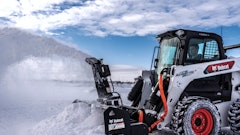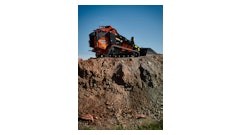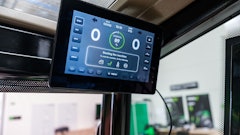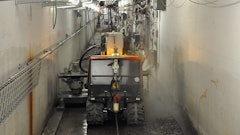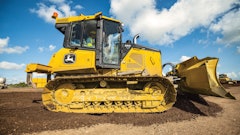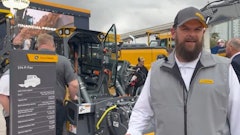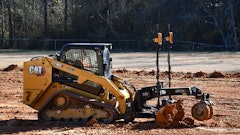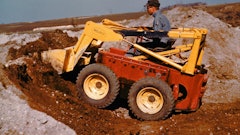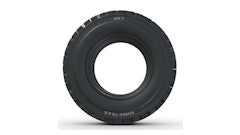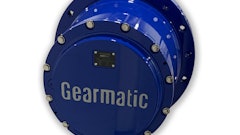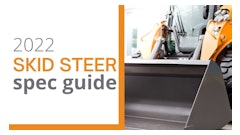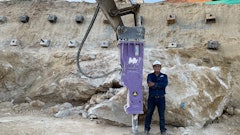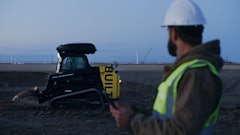
Like many contractors, Troy Jones wants, and needs, more power from his skid-steer loaders to move more dirt in less time. The nearly 20 Case 90XT machines that are part of the equipment fleet at Eco Tech Construction in Grimes, IA, do a variety of jobs from finish grading, digging and backfilling to material handling, sweeping and raking. Because the company is diversified — specializing in everything from underground utility work, heavy highway paving and grading to residential subdivisions and commercial footings, floors and walls — multiple skid steers are typically always on site.
While power is important, Jones, general superintendent for Eco Tech, doesn't want the machines to get any bigger. "The size of these machines is right where we need them to be," he says. "We've had other machines of larger size where there have been some restrictions. This size machine is very operator friendly with good vision to each corner of the bucket. And in our commercial parking lot division, we like the smaller size machines because there are other contractors in the area performing work at the same time."
As a landscape contractor, Joel Butler, owner of Suburban Services, Inver Grove Heights, MN, is another good example of why manufacturers need to strike a balance between dimensional size and power. He needs a machine that can move sand and gravel, as well as pallets of sod and heavy snow. "If I'm pushing through a pile of gravel or black dirt, I need a machine with as much power as possible," he states. "The more power I have, the faster the machine can push through it."
Power is also needed to lift and move loads of retaining wall blocks and paver stones. "If I'm moving forward at the same time I'm using the arms to move the bucket up and down through dirt or gravel, I need a lot of power to run the hydraulic pumps," says Butler. "You can really bog down a machine if you're trying to work it too fast. But with as much power as these new machines have, they can power right through it."
At the same time, Butler needs equipment that can maneuver in and around tight lots. His fleet of skid steers includes three Bobcat S185s and a larger S220. "If I need to access a certain area for landscaping, I need to have a small machine to get into that area," he says.
Turbocharging packs power
Requests for increased power in a compact package are typical, says Mike Fitzgerald, product representative for Bobcat. "Many contractors face size restrictions, such as in new housing developments where they are working on 5- to 10-ft. lot lines," he notes. "Equipment needs to be narrow enough to move between buildings, as well as inside them for renovations, demolition and industrial work. Even if contractors have more space to work, they want to maintain transportability of the machines. Everyone wants to be able to do more, but there is dimensional criteria that we can't step out of."
A perusal of the newest machines on the market highlights how manufacturers are finding a balance between power and size. Models have higher horsepower engines with higher capacity hydraulic and cooling systems, yet dimensionally they remain unchanged.
"Knowing that size continues to be a key feature, we concentrated on keeping our 400 Series chassis the same dimensions while increasing ground torque and productivity," says Jim Hughes, marketing manager, Case Construction Equipment.
Turbocharging gives manufacturers the ability to pack more power into an engine. And more manufacturers are offering additional models with turbocharging. Take Volvo, for example. When it stepped into the skid-steer loader market in 2003, it offered just one turbocharged machine. Today, three of its five models feature boosted power.
"Traditionally, the only way to gain horsepower has been to increase engine size," says Bill Sauber, product marketing manager for skid steers at Volvo. "But there comes a point when engine size begins to affect machine size — a bigger engine means a bigger machine. But by adding a turbocharger, we can provide more horsepower with the same size engine that you could get when it is normally aspirated."
A turbocharger uses exhaust to spin a compressor, which draws additional air in and forces it into the cylinder. "So you're able to stuff more air into the same size engine," says Sauber.
Bobcat is also providing more turbocharged models. "The vast majority of models we offer feature turbocharged engines," says Fitzgerald. "We've seen a progression away from naturally aspirated machines toward turbocharging so contractors can get more power out of the same size package. With turbocharging, we can gain 10% to 20% in horsepower with similarly-sized naturally-aspirated engines."
Emission regulations have sparked additional changes to the engines. According to Sauber, increasing the number of valves per cylinder from two to four in Volvo's new engines helps lower emissions, as well as boost torque rise — by as much as 25% in some models. "Torque rise is the difference between maximum torque level and the torque at a rated horsepower level," he explains. "It's what gives you good recovery for working hard in tough conditions."
Case has also seen a performance boost in its skid steers equipped with Tier II engines. "The Case large-displacement/high-torque engines have contributed to significant increases in productivity," says Hughes. "They offer proven reliability, long engine life and maximum productivity for more power at lower rpms, which means less stress on the engine and components."
Hydraulic system overhaul
Hydraulic systems, which influence both performance and operator comfort, are also getting an overhaul on many new models.
In the case of Komatsu skid-steer models, PPC controls (Proportional Pressure Control) allow low effort control of all functions. "We are now able to control multifunction of the hydraulic control valve for the boom/bucket while provide exacting travel control in all applications," says Robert Beesley, product manager for skid steers, Komatsu America Corp. "The PPC control also allows the utilization of our Automatic Power Control (APC) that matches hydraulic output to available engine power."
In addition, a pattern control option gives operators the flexibility to choose between single- and two-lever travel controls so two or more operators using the same machine can select personal preferences for optimum performance, productivity and safety.
Volvo has also taken personal preference into consideration, offering either traditional hand and foot controls or hydraulic pilot controls for steering, driving and controlling attachments. "Pilot controls have become more popular on skid steers because of their use in other machines, such as mini-excavators and backhoe-loaders," says Sauber. "We definitely see this as an area for growth. First-time operators almost invariably want to try pilot controls — especially younger operators who are comfortable with joystick controls on video games."
Pilot controls also reduce operating effort. Consequently, some operators may find them more comfortable to use.
To further enhance controllability, Volvo has added a foot throttle in addition to the hand throttle. "A foot throttle can help improve fuel economy because you can accelerate when you need more power for traveling, bucket work or faster cycling," Sauber says. "Then when you're doing finer control work, you can back off for more control. And since you're running at lower engine speeds, you will lower your fuel consumption."
Controls aren't the only significant change in hydraulics. "Customers continue to want more performance," says Fitzgerald. "The biggest change we've seen has been to increase flow and pressure."
Flow affects the speed at which an attachment, such as a trencher, turns. Pressure affects how well an attachment works in tough ground conditions without stalling. "We've seen dramatic increases in both," says Fitzgerald.
Standard flow rates were previously around 11 to 17 gpm. Today, they range from 14 to 21 gpm, while high-flow machines can reach as high as 37 gpm. Pressures have seen the same dramatic changes, increasing from a standard 2,000 psi to as much as 3,300 psi. "These flow and pressure increases allow customers to do more work with the machine," says Fitzgerald.
Keeping it cool
Any time a manufacturer adjusts the power, it also needs to reevaluate the cooling system.
For example, Komatsu's side-by-side radiator and oil cooler are designed for maximum cooling effect. "This design, coupled with the controlled environment under the hood, allows these machines to run in severe applications and adverse conditions," says Beesley.
At Case, engineers have changed the priority of the cooling package to place more emphasis on improved hydraulic cooling capacity. "We have also increased the surface area of the radiator to improve engine cooling," says Hughes.
On K-Series machines, Bobcat engineers moved to a hydraulically-driven cooling fan that senses machine operating temperatures, then self-regulates to rotate only as fast as needed. "When it's cold outside, the fan doesn't run, or it runs at low speeds," says Fitzgerald. "This helps to reduce noise and improve operator comfort. On warm days or in the summer, when a machine is operating with a high-load hydraulic attachment such as a mower, planer or trencher, the fan can turn faster than it could when it was directly related to the engine rpm.
"Everything works together," he adds. "Whenever you increase performance on the front side, you need to make changes on the back side, too. It makes the whole package work better together."








